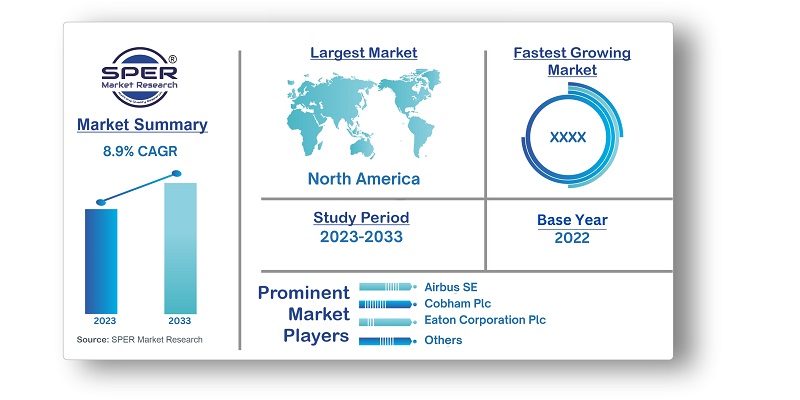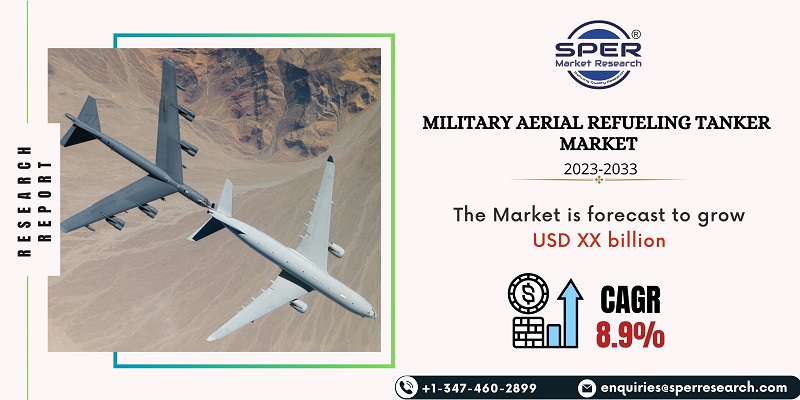
Military Aerial Refueling Tanker Market Growth, Size, Trends, Revenue, Scope and Future Outlook
Military Aerial Refueling Tanker Market Size- By Type, By Component, By Aerial Refueling Technologies, By Distribution Channel- Regional Outlook, Competitive Strategies and Segment Forecast to 2033
| Published: Mar-2023 | Report ID: AERO2302 | Pages: 1 - 250 | Formats*: |
| Category : Aerospace and Defence | |||
- Joint development and acquisition approach: The market growth of military aerial refueling tankers is being driven by the joint development and acquisition approach. However, the emergence of unmanned jet tankers is a factor that may hinder market growth.
- Increasing financial support for a multi-layered air defence system: The primary trend in the market is the increasing investments in the development and implementation of multi-layered air defense networks.

- Opportunities:
- Rising Defence Budgets: Opportunities for investment in military aerial refuelling tankers are presented by rising defence budgets in a number of nations across the world. Defence modernization initiatives and the need to improve operational capabilities foster market growth.
- Geopolitical Tensions and Conflicts: Heightened geopolitical tensions and ongoing hostilities in several locations feed demand for military aircraft, which in turn fuels demand for aerial refuelling tankers. During missions and operations, these tankers are essential in increasing the range and endurance of military aircraft.
- Challenges:
- High expenses for development and acquisition: There are high costs associated with developing and acquiring military aerial refuelling tankers, including those for manufacture, research and development, and maintenance. High prices might be problematic for nations with constrained defence budgets or for those that prioritise other defence needs.
- Prerequisites for advanced technology: Complex technological requirements are needed for military aerial refuelling tankers in order to conduct refuelling operations safely and effectively. It can be difficult for manufacturers to meet strict technical requirements and regulatory norms, which increases development time and expenses.

| Report Metric | Details |
| Market size available for years | 2019-2033 |
| Base year considered | 2022 |
| Forecast period | 2023-2033 |
| Segments covered | By Type, By Component, By Aerial Refueling Technologies, By Distribution Channel |
| Regions covered | Asia Pacific, Europe, Middle East and Africa, North America, Latin America |
| Companies Covered | Airbus SE, Cobham Plc, Eaton Corporation Plc, Embraer SA, General Electric Co., Israel Aerospace Industries Ltd., Liebherr-International Deutschland GmbH, Lockheed Martin Corp., Rostec State Corp, The Boeing Co, Others |
- Air Force and Navy Officials
- Defense Industry and Manufacturers
- Defense Procurement Agencies
- International Defense Allies
- Maintenance and Support Personnel
- Military Forces
- Others
| By Type: |
|
| By Component: |
|
| By Aerial Refueling Technologies: |
|
| By Distribution Channel: |
|
- Global Military Aerial Refueling Tanker Market Size (FY’2023-FY’2033)
- Overview of Global Military Aerial Refueling Tanker Market
- Segmentation of Global Military Aerial Refueling Tanker Market By Type (Manned, Unmanned)
- Segmentation of Global Military Aerial Refueling Tanker Market By Component (Boom, Drogues, Hoses, Refueling Probes)
- Segmentation of Global Military Aerial Refueling Tanker Market By Aerial Refueling Technologies (Boom-and-receptacle, Probe and Drogue)
- Segmentation of Global Military Aerial Refueling Tanker Market By Distribution Channel (Aftermarket, OEM)
- Statistical Snap of Global Military Aerial Refueling Tanker Market
- Expansion Analysis of Global Military Aerial Refueling Tanker Market
- Problems and Obstacles in Global Military Aerial Refueling Tanker Market
- Competitive Landscape in the Global Military Aerial Refueling Tanker Market
- Impact of COVID-19 and Demonetization on Global Military Aerial Refueling Tanker Market
- Details on Current Investment in Global Military Aerial Refueling Tanker Market
- Competitive Analysis of Global Military Aerial Refueling Tanker Market
- Key Prominent Players in the Global Military Aerial Refueling Tanker Market
- SWOT Analysis of Global Military Aerial Refueling Tanker Market
- Global Military Aerial Refueling Tanker Market Future Outlook and Projections (FY’2023-FY’2033)
- Recommendations from Analyst
1.1. Scope of the report1.2. Market segment analysis
2.1. Research data source
2.1.1. Secondary Data2.1.2. Primary Data2.1.3. SPER’s internal database2.1.4. Premium insight from KOL’s
2.2. Market size estimation
2.2.1. Top-down and Bottom-up approach
2.3. Data triangulation
4.1. Driver, Restraint, Opportunity and Challenges analysis
4.1.1. Drivers4.1.2. Restraints4.1.3. Opportunities4.1.4. Challenges
4.2. COVID-19 Impacts of the Global Military Aerial Refueling Tanker Market
5.1. SWOT Analysis
5.1.1. Strengths5.1.2. Weaknesses5.1.3. Opportunities5.1.4. Threats
5.2. PESTEL Analysis
5.2.1. Political Landscape5.2.2. Economic Landscape5.2.3. Social Landscape5.2.4. Technological Landscape5.2.5. Environmental Landscape5.2.6. Legal Landscape
5.3. PORTER’s Five Forces
5.3.1. Bargaining power of suppliers5.3.2. Bargaining power of buyers5.3.3. Threat of Substitute5.3.4. Threat of new entrant5.3.5. Competitive rivalry
5.4. Heat Map Analysis
6.1. Global Military Aerial Refueling Tanker Market Manufacturing Base Distribution, Sales Area, Product Type6.2. Mergers & Acquisitions, Partnerships, Product Launch, and Collaboration in Global Military Aerial Refueling Tanker Market
7.1. Global Military Aerial Refueling Tanker Market Value Share and Forecast, By Type, 2023-20337.2. Manned7.3. Unmanned
8.1. Global Military Aerial Refueling Tanker Market Value Share and Forecast, By Component, 2023-20338.2. Boom8.3. Drogues8.4. Hoses8.5. Refueling Probes
9.1. Global Military Aerial Refueling Tanker Market Value Share and Forecast, By Aerial Refueling Technologies, 2023-20339.2. Boom-and-receptacle9.3. Probe and Drogue
10.1. Global Military Aerial Refueling Tanker Market Value Share and Forecast, By Distribution Channel, 2023-203310.2. Aftermarket10.3. OEM
11.1. Global Military Aerial Refueling Tanker Market Size and Market Share
12.1. Global Military Aerial Refueling Tanker Market Size and Market Share By Type (2019-2026)12.2. Global Military Aerial Refueling Tanker Market Size and Market Share By Type (2027-2033)
13.1. Global Military Aerial Refueling Tanker Market Size and Market Share By Component (2019-2026)13.2. Global Military Aerial Refueling Tanker Market Size and Market Share By Component (2027-2033)
14.1. Global Military Aerial Refueling Tanker Market Size and Market Share By Aerial Refueling Technologies (2019-2026)14.2. Global Military Aerial Refueling Tanker Market Size and Market Share By Aerial Refueling Technologies (2027-2033)
15.1. Global Military Aerial Refueling Tanker Market Size and Market Share By Distribution Channel (2019-2026)15.2. Global Military Aerial Refueling Tanker Market Size and Market Share By Distribution Channel (2027-2033)
16.1. Global Military Aerial Refueling Tanker Market Size and Market Share By Region (2019-2026)16.2. Global Military Aerial Refueling Tanker Market Size and Market Share By Region (2027-2033)16.3. Asia-Pacific
16.3.1. Australia16.3.2. China16.3.3. India16.3.4. Japan16.3.5. South Korea16.3.6. Rest of Asia-Pacific
16.4. Europe
16.4.1. France16.4.2. Germany16.4.3. Italy16.4.4. Spain16.4.5. United Kingdom16.4.6. Rest of Europe
16.5. Middle East and Africa
16.5.1. Kingdom of Saudi Arabia16.5.2. United Arab Emirates16.5.3. Rest of Middle East & Africa
16.6. North America
16.6.1. Canada16.6.2. Mexico16.6.3. United States
16.7. Latin America
16.7.1. Argentina16.7.2. Brazil16.7.3. Rest of Latin America
17.1. Airbus SE
17.1.1. Company details17.1.2. Financial outlook17.1.3. Product summary17.1.4. Recent developments
17.2. Cobham Plc
17.2.1. Company details17.2.2. Financial outlook17.2.3. Product summary17.2.4. Recent developments17.3. Eaton Corporation Plc
17.3.1. Company details17.3.2. Financial outlook17.3.3. Product summary17.3.4. Recent developments
17.4. Embraer SA
17.4.1. Company details17.4.2. Financial outlook17.4.3. Product summary17.4.4. Recent developments
17.5. General Electric Co.
17.5.1. Company details17.5.2. Financial outlook17.5.3. Product summary17.5.4. Recent developments
17.6. Israel Aerospace Industries Ltd.
17.6.1. Company details17.6.2. Financial outlook17.6.3. Product summary17.6.4. Recent developments
17.7. Liebherr-International Deutschland GmbH
17.7.1. Company details17.7.2. Financial outlook17.7.3. Product summary17.7.4. Recent developments
17.8. Lockheed Martin Corp.
17.8.1. Company details17.8.2. Financial outlook17.8.3. Product summary17.8.4. Recent developments
17.9. The Boeing Co
17.9.1. Company details17.9.2. Financial outlook17.9.3. Product summary17.9.4. Recent developments
17.10. Others
SPER Market Research’s methodology uses great emphasis on primary research to ensure that the market intelligence insights are up to date, reliable and accurate. Primary interviews are done with players involved in each phase of a supply chain to analyze the market forecasting. The secondary research method is used to help you fully understand how the future markets and the spending patterns look likes.
The report is based on in-depth qualitative and quantitative analysis of the Product Market. The quantitative analysis involves the application of various projection and sampling techniques. The qualitative analysis involves primary interviews, surveys, and vendor briefings. The data gathered as a result of these processes are validated through experts opinion. Our research methodology entails an ideal mixture of primary and secondary initiatives.



Frequently Asked Questions About This Report
PLACE AN ORDER
Year End Discount
Sample Report
Pre-Purchase Inquiry
NEED CUSTOMIZATION?
Request CustomizationCALL OR EMAIL US
100% Secure Payment






Related Reports
Our Global Clients
Our data-driven insights have influenced the strategy of 200+ reputed companies across the globe.




















